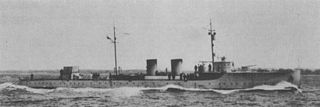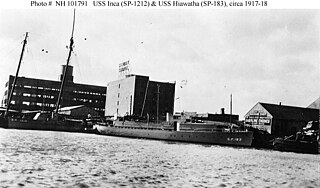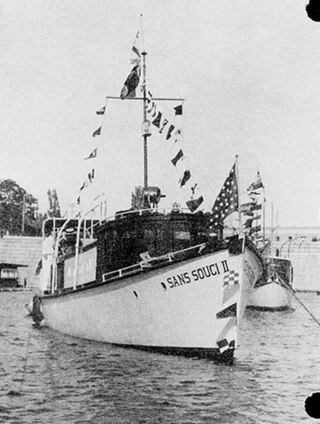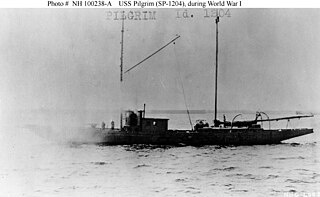
USS Winchester (SP-156) was an armed yacht that served in the United States Navy as a patrol vessel from 1917 to 1919. Prior to and following World War I, Winchester was a private yacht, later renamed Renard. In World War II, Renard was requisitioned for use in the Royal Canadian Navy as a patrol vessel, keeping her name. She was returned to her owners in 1944.

USS Edithena was a United States Navy patrol vessel in commission from 1917 to 1919 that saw service during World War I. Prior to her U.S. Navy service, she operated as the private motor yacht Edithena from 1914 to 1917. After the conclusion World War I, she served as the fishery patrol vessel USFS Widgeon in the fleet of the United States Bureau of Fisheries from 1919 to 1940 and as US FWS Widgeon in the fleet of the Fish and Wildlife Service from 1940 to 1942. During World War II, she returned to U.S. Navy service from 1942 to 1944 as the yard patrol boat USS YP-200. By 1947 she had returned to private ownership, first as Edithena and during the 1970s and 1980s as the fishing vessel Ila Mae.

An armed yacht was a yacht that was armed with weapons and was typically in the service of a navy. The word "yacht" was originally applied to small, fast and agile naval vessels suited to piracy and to employment by navies and coast guards against smugglers and pirates. Vessels of this type were adapted to racing by wealthy owners. The origin of civilian yachts as naval vessels, with their speed and maneuverability, made them useful for adaptation to their original function as patrol vessels. In the United States Navy armed yachts were typically private yachts expropriated for government use in times of war. Armed yachts served as patrol vessels during the Spanish–American War and the World Wars. In the latter conflicts, armed yachts were used as patrol vessels, convoy escorts, and in anti-submarine duties. In the United States, yachts were purchased from their owners with the owners given an option to repurchase their yacht at the close of hostilities.
USS Helena I (SP-24) was an armed yacht that served the United States Navy as a patrol vessel from 1917 to 1919.

USS Joyance (SP-72) was an armed yacht that served in the United States Navy as a patrol vessel from 1917 to 1919.

The second USS Commodore (SP-1425) was an armed motorboat that served in the United States Navy as a patrol vessel from 1917 to 1919. It was financed by Herbert M. Sears as part of the "Eastern Yacht Club 62 footers".

The second USS Sovereign (SP-170) was an armed yacht that served in the United States Navy as a patrol vessel from 1918 to 1919.

The first USS Hiawatha (SP-183) was an armed yacht that served in the United States Navy as a patrol vessel from 1917 to 1920.
USS Gladiola (SP-184) was an armed yacht that served in the United States Navy as a patrol vessel from 1917 to 1919.

The first USS Sabalo (SP-225) was a United States Navy patrol vessel in commission from 1917 to 1919. Following World War I, Sabalo was sold to private interests before returning to service as a patrol vessel in World War II, this time with the Royal Canadian Navy, renamed Cougar. Returning to private ownership following the war, the vessel sank in a hurricane in 1950.

USS Sans Souci II (SP-301) was an armed motorboat that served in the United States Navy as a patrol vessel from 1917 to 1919.

The second USS Sylvia (SP-471), later USS SP-471, was a United States Navy patrol vessel in commission from 1917 to 1919.
USS Fli-Hawk (SP-550) was a United States Navy patrol vessel in commission from 1917 to 1919.

USS Raeo (SP-588) was a United States Navy patrol vessel in commission from 1917 to 1919. Prior to her U.S. Navy service, she operated as the motor passenger vessel Raeo from 1908 to 1917. After the conclusion of her U.S. Navy career, she served as the fishery patrol vessel USFS Kittiwake in the United States Bureau of Fisheries fleet from 1919 to 1940 and as US FWS Kittiwake in the Fish and Wildlife Service fleet from 1940 to 1942 and from 1944 to at least 1945, and perhaps as late as 1948. During World War II, she again served in the U.S. Navy, this time as the yard patrol boat USS YP-199. She was the civilian fishing vessel Raeo from 1948 to 1957, then operated in various roles as Harbor Queen from 1957 to 1997. She became Entiat Princess in 1998 and as of 2009 was still in service.

USS Cobra (SP-626) was a United States Navy patrol vessel in commission from 1917 to 1919 that operated during World War I. She originally was constructed as a private motorboat. After the conclusion of her U.S. Navy career, she served as the fishery patrol vessel USFS Petrel for the United States Bureau of Fisheries from 1919 to 1934, operating in the waters of the Territory of Alaska.

The second USS Calypso (SP-632) was a United States Navy patrol vessel in commission from 1917 to 1919. She originally operated as the private motorboat Calypso from 1909 to 1917. After the conclusion of her U.S. Navy career, she served as the fishery patrol vessel in the United States Bureau of Fisheries fleet from 1919 to 1940 as USFS Merganser and in the Fish and Wildlife Service fleet as US FWS Merganser from 1940 to 1942.
The second USS Wissahickon (SP-852), which also served as USS SP-852, was a United States Navy patrol vessel in commission from 1917 to 1918.

The third USS Pilgrim (SP-1204) was a United States Navy patrol vessel in commission from 1917 to 1919.
USS Herman S. Caswell (SP-2311), was a United States Navy patrol vessel in service from 1918 to 1919.

USS Audwin (SP-451) was a patrol vessel that served in the United States Navy from 1917 to 1919. She then was a survey vessel in the United States Coast and Geodetic Survey from 1919 to 1927.














